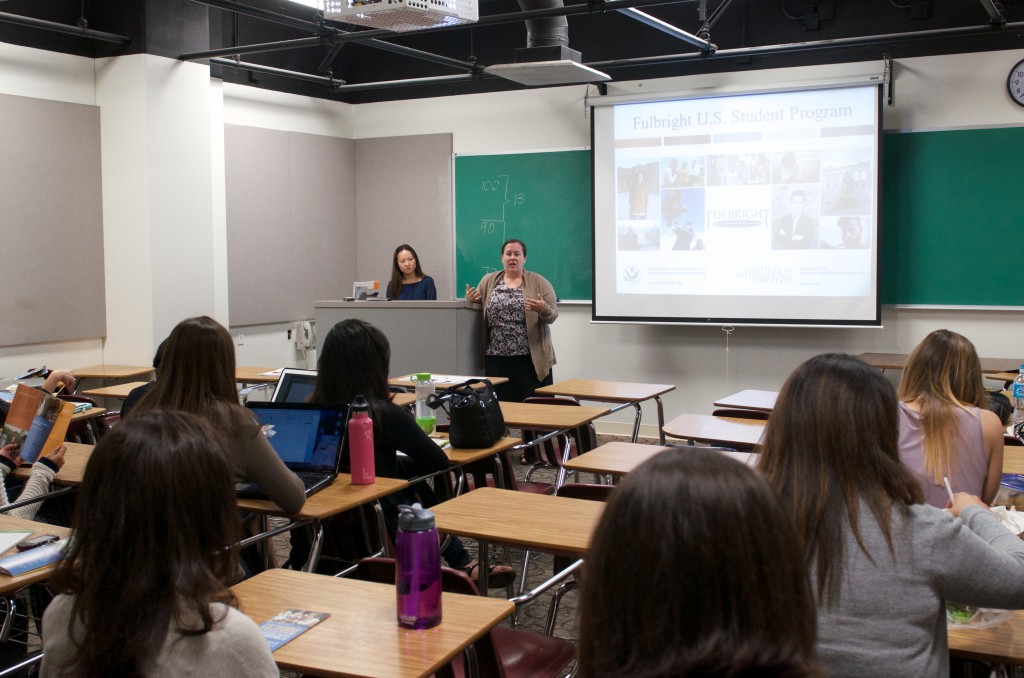
“This experience may take you out of your comfort zone, but it will definitely change you and shape you for the better.”
With that, Fulbright alumni ambassador Rebecca Littman-Smith inspired a classroom full of students at California State University, Dominguez Hills who are interested in applying for the prestigious Fulbright U.S. student program.
During a presentation held on June 19 on campus, Littman-Smith offered tips, advice and information on the Fulbright U.S. Student grant program that is designed to send American students to a foreign country for one academic year to work on a study/research project or teach through the English Teaching Assistant (ETA) program.
The highly selective grant allows Fulbright students to meet, work, live with and learn from the people of their host country without the concern of the typical financial costs associated with living and working abroad for a year.
“Tie what it is you want to do with who you already are,” Littman-Smith said. “You have your own set of experiences and you have so much to give to others and learn for yourself.”
In 2010, recently graduated from the University of Oregon, Littman-Smith was awarded a Fulbright to spend a year in Finland conducting research on the use of wood as a primary building material in Finnish architecture and how modern building techniques could address the need for refugee transitional housing around the world. She currently works for an architecture firm in Oregon and describes her experience as a Fulbright student as “transformative.”
CSU Dominguez Hills President Willie Hagan has made the expansion of international experiences for students as well as faculty a priority during his tenure, encouraging students to apply for such programs as Fulbright and gain invaluable experiences in the process. More than a dozen CSUDH professors have either been Fulbright scholars or lecturers in countries ranging from Turkey to Malaysia to Zimbabwe; three professors have been awarded this year alone. Katlin Choi, a former graduate student in the Negotiation, Conflict Resolution and Peacebuilding (NCRP) program on campus, is the only CSU Dominguez Hills student to be chosen for the Fulbright student program,and was on hand to offer advice as well.
“I really wanted to connect with my ancestral roots, and that’s why I chose Macau,” said Choi who in 2010 traveled to the University of Macau to teach English. She was born in Hong Kong but moved to the U.S. at the age of 7 and speaks limited Cantonese. “I was exposed to such a new world and culture, and learning so much.
When asked what she would tell a student who was unsure whether or not the Fulbright program was for them, Choi stressed that it was a once-in-a-lifetime experience.
“You have nothing to lose and everything to gain,” she said.
The Fulbright program was created in 1946 when President Harry S. Truman signed a bill into law that called for the use of surplus war property to fund the promotion of international goodwill through the exchange of students in the fields of education, culture and science.
Named after the law’s creator, Senator J. William Fulbright, it is the U.S. government’s flagship international educational exchange program and has fostered bilateral relationships with citizens and governments around the world for more than six decades. The program currently awards nearly 1,900 grants annually in all fields of study and operates in more than 140 countries.
Giuseppina Wright, a CSU Dominguez Hills alumni (Class of 2013, M.A. in NCRP) who is interested in applying for the Fulbright program, attended the presentation and appreciated the perspectives of those who had previously participated in the program.
“What made the presentation unique was the presenters’ enthusiasm in sharing their experience,” Wright said. Originally from Sweden, she hopes to either revisit her birthplace or work in Spain on behalf of the Fulbright program if accepted.
“I walked away from the presentation with useful tips and tools,” she said. “I want to represent America’s rich diversity while fostering cultural collaboration and mutual understanding.”